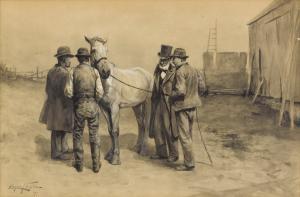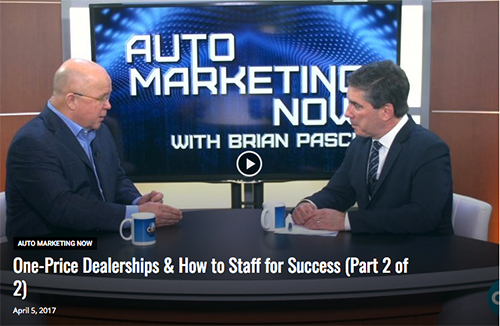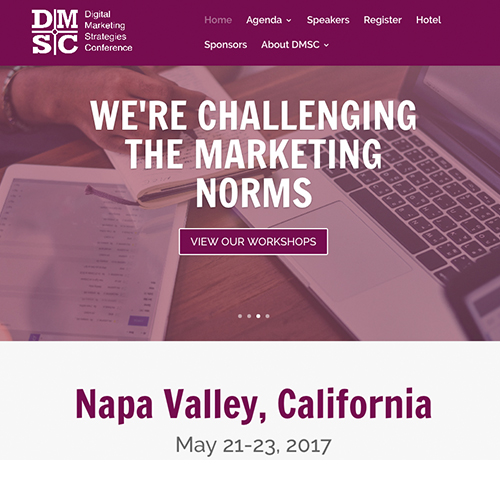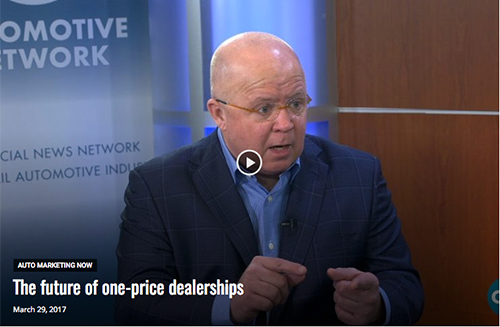We’ll be presenting at Digital Dealer 23 at the Paris Hotel in Las Vegas, September 18-20. If you are curious about one-price selling you’ll want to attend our seminar entitled: It’s Time to put Horse Trading Out to Pasture and Embrace One-Price Selling. See you in Las Vegas! Watch the video preview above for more information.
Staff for Success – One-Price Dealerships
Here is part 2 of 2 of our interview with Brian Pasch on CBT News. We discuss the one price or up front pricing business model and the important role of recruiting and creating a career path. In “How to Staff for Success”, we will address:
- The Enterprise Rental Car strategy for attracting young talent
- Recruiting recent college graduates
- Providing a predictable income
- The importance of a career path
- Work/Life balance
- Serious training versus “sit by Mike”
- Single Point of Contact
- Simplified F&I menu
- Increasing the throughput of the dealership
Curious about up front pricing or single point of contact? Call Alan at 612.308.8539
We’re Presenting at DMSC
We are pleased to have been invited to speak at DMSC (Digital Marketing Strategies Conference) on May 22, 2017, in Napa, California. The Digital Marketing Strategies Conference is a high-level executive planning event, designed to assist automotive dealers with creating a market-dominating strategy for the year ahead. Held annually, this event brings the top thought leaders from the automotive marketing industry to beautiful Napa Valley for an intimate conference experience unlike any other. This event is for the progressive dealer interested in learning how to be a part of their dealership’s digital strategy and lead their teams in a digital age. Our presentation on the one-price business model is just one of many that will be delivered by industry experts.
Ryan Adams Group’s presentation, Why One-Price and Why Now? , kicks off the first day of the conference. We will address how the one-price business model affects recruiting challenges, margin compression, differentiation through customer experience design, e-commerce and speed of transaction. One-price dealer financial composites will illustrate how a one-price business model impacts profitability.
Interested in attending? Get information here.
The Future of One-Price Dealerships
In our interview with Brian Pasch on CBT News, we discuss why a one-price or up-front pricing business model may be the future for your dealership. Topics that we address include:
- Most dealers are already very close to one-price, particularly on used cars.
- How upfront pricing affects recruiting.
- E-commerce and online payment calculators – how can the payment be accurate when the price is not?
- Using up-front pricing to speed the transaction.
- Selling a new way to buy a car before you sell the car – using a concept statement
- Does up – front pricing lead to greater customer satisfaction?
- How long does it take to switch to a new, up-front pricing business model?
Stay tuned for a second interview that specifically addresses recruiting millennials to a business that employs a up-front pricing business model.
Fresh Icing on the Same Stale Cake

Auto Dealers, I invite you to read what Doug Stephens, Founder, and President of Retail Prophet has to say about customer experience design. He writes in an Op-ed piece for London-based “Business of Fashion” that most customer experience design is just fresh icing on the same stale cake.
When dealers remodel their showroom, add some iPads and give their employees hospitality training they are doing very little to re-engineer the customer experience. As Doug Stephens says it’s just Fresh Icing…
Unless you are eliminating friction and reducing the time it takes to sell a car by employing a one-price business model you are probably just adding “fresh icing” to a way of selling a car that continues to frustrate auto shoppers. Do iPads and marble floors actually change the experience for your customers? Are you increasing transparency and reducing anxiety with these expensive, yet superficial improvements? Are you still running 10 lanes of sales traffic into 3 lanes of F&I capability?
Unless you have a new recruiting strategy backed by a compensation model that addresses today’s young workforce you are not re-engineering the customer experience. To deliver the experience of the future you will need to recruit, train, nurture and retain the worker of the future. Millennials value meaning, demand work-life balance and prefer a stable, non-commission pay plan. They are looking for a career path, not just a job. Scoff all you want. I know it’s not how you and I were raised but this is a new reality and it’s not going away. Young workers (our future) don’t want to negotiate with their friends and neighbors over the profit in a car sale.
Beautiful facilities enhance shopping for a vehicle. iPads can facilitate communication. Every interaction between an employee and guest is better when it is handled with civility and grace. But, until we re-engineer the decades-old mechanics of buying a car significant advances in customer experience are going to be elusive.
Read Doug Stephen’s entire article here.
If you are curious about making the journey to one-price selling and single point of contact, Ryan Adams Group is here to help.
Awareness versus Familarity

How often have we heard the expression “if we could only increase our brand awareness we could increase sales?” Awareness has a wide range of meanings. Some people may assume when I am “aware” I know everything about a brand or a product. Others assume that if I am aware I have only heard of the brand or product. That’s a wide range of understanding, so what is the difference? There can be all levels of awareness – from I just heard the name and I don’t know anything else all the way to a high a level of understanding of the brand or product.
Questions that measure levels of awareness provide some insight. A typical research question to measure awareness is “have you heard of brand X? Yes or No”
The percent of people that answer yes gives an estimate of awareness. Unfortunately, our past studies have shown that awareness has a low correlation to purchase. Being aware that a brand exists is not enough to stimulate purchase. Since the goal is raising sales we must have a measurement that can predict sales.
Our preferred measure is “familiarity.” Familiarity means “I know something about the brand or product. Familiarity means I have an impression or point of view about your product or brand. It is possible to have high scores for awareness and low scores for familiarity.
If your business is under-performing you may want to look at the level of awareness and familiarity you have. You must create awareness to get familiarity. However, awareness alone is not sufficient to drive purchase! Familiarity is the beginning of engagement with a brand that leads to purchase.
Ryan Adams Group is here to help you. We are committed to a better customer car buying experience. Call if you are curious or visit us at RyanAdamsGroup.com.
Is it Time To put Horse Trading out to Pasture?

Glenn Mercer (GM Automotive LLC) published an independent study prepared for NADA in January 2017 entitled The Dealership of Tomorrow: 2025, Retail automotive trends for the next decade. The 87-page document is an interesting read. On pages 42 and 43 we like Mercer’s brief comments on negotiated transactions.
“…negotiated prices are just an artifact of history: it seems that we accept haggling about cars because we haggled over their predecessors: horses. As laid out in Steven Gelber’s excellent book on the early days of motoring, Horse Trading in the Age of Cars, we argued over horses because every horse was different, and because they were risky (they were usually sold without warranties and without the possibility of refund). When we replaced horses with cars, we stayed with the same system – even as virtually every other good was migrating to fixed prices (led by department stores such as Macy’s and Wannamaker’s in the late 1800s, according to Gelber). Maybe, a century later, it is time to put negotiated prices out to pasture, just as we did with our horses.”
Isn’t it amazing that with the changes in retailing over the last century that the automobile is still a negotiated transaction? In an age where companies such as Amazon and Apple are delighting customers with transparent pricing and sales processes that reduce friction, we are still clinging to a basic method of transacting business that is 100 years old and has been abandoned by virtually every other retail channel.
The majority of customers do not enjoy the time commitment required, uncertainty and stress involved in negotiating a car purchase. We believe there are 2 primary reasons for this.
- Most customers don’t get much practice negotiating for personal purchases. They have not developed the skill necessary to conclude a transaction confidently. Therefore they approach negotiation with anxiety and, even when the transaction is completed, may not be sure whether or not they arrived at a fair bargain.
- Today there are numerous examples of better ways to transact. The effect that Amazon has had on price transparency and ease of purchase are influencing retail practices in virtually every channel. Technology is driving the availability of information (the dealer no longer knows more than the customer) and has facilitated methods of purchasing that have greatly reduced friction (Amazon one-click, for example). Customers are disappointed when a purchase of the expense and emotional significance of a vehicle is not as enjoyable as purchases in other areas of their lives.
Curious about converting to a non-negotiating business model? Ryan Adams Group is here to help. Call Alan Krutsch at 612.208.8539 for information, examples, and answers to your questions.
Ryan Adams Group-The Roadmap to One-Price Selling

We’ve just returned from NADA100 in New Orleans and were pleased but not surprised by the amount of conversation surrounding employee retention and customer experience. Clearly recruiting the right employees and then training, motivating and retaining them is key to creating a winning customer experience. Using a One-Price selling system can increase customer satisfaction, employee retention and reduce transaction times. Ryan Adams Group guides dealers who are converting to One-Price selling in an effort to create a great customer experience. Check out the Roadmap to becoming a Negotiation-Free dealership.
In our initial assessment, we determine the dealership’s readiness to embark on the One-Price journey. By far the most important indicators of success are management buy-in and the willingness of the organization to embrace and manage change. Change management is a challenge for many organizations. Ryan Adams Group has successfully managed this process for over 60 dealers who have converted to the One-Price model. Is facing the challenge and embracing change worth it? We believe it is. If you are interested in learning more we can arrange a visit to a One-Price dealership where you can ask questions and learn about the transition from the retail employees who successfully implemented this process.



